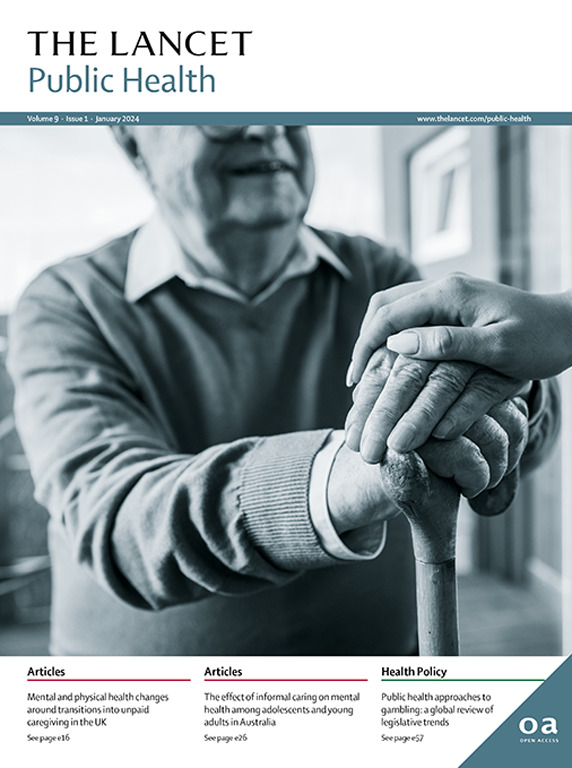Adverse childhood experiences in firstborns and mental health risk and health-care use in siblings: a population-based birth cohort study of half a million children in England
IF 25.2
1区 医学
Q1 PUBLIC, ENVIRONMENTAL & OCCUPATIONAL HEALTH
引用次数: 0
Abstract
Background
Adverse childhood experiences (ACEs) often affect multiple children within families, yet studies tend to focus on the health outcomes of individual children, underestimating the needs of affected families. We aimed to examine the association between firstborns exposed to ACEs between 1 year before and 2 years after birth (the first 1000 days) and the risks of mental health problems, mental health-related health-care contacts, and all-cause hospital admissions in multiple children from the same mother, compared to firstborns without ACEs.Methods
We derived a population-based birth cohort in England using linked electronic health records for first-time mothers (aged 14–55 years) with their children (born 2002–18). We followed up the cohort from 1 year before birth up to 18 years after birth across the Clinical Practice Research Datalink GOLD and Aurum databases (primary care), Hospital Episode Statistics (secondary care), and the Office of National Statistics (death registrations) between April 1, 2001, and March 31, 2020. We included six different ACE domains, including child maltreatment, intimate partner violence, maternal substance misuse, maternal mental health problems, adverse family environments, and high-risk presentations of child maltreatment, in the records of the mother or the firstborn in the first 1000 days. The primary outcome was the number of children (aged 5–18 years) with recorded mental health problems per mother. We used adjusted and weighted negative binomial regression models to estimate incidence rate ratios.Findings
Of 333 048 firstborns and their mothers, 123 573 (37·1%) had any ACEs between 1 year before and 2 years after birth, and 65 941 (19·8%) of all mothers had at least one child with a mental health problem between ages 5 years and 18 years (median follow-up 11·4 years [IQR 9·2–14·1]). Mothers with firstborns with ACEs had 1·71 (95% CI 1·68–1·73) times as many children in total with mental health problems (mean 29·8 children per 100 mothers, 29·4–30·1) compared with mothers without firstborns with ACEs (mean 17·4 children per 100 mothers, 17·3–17·6), translating into a mean difference of 12·3 (95% CI 11·9–12·7) additional children with mental health problems per 100 mothers. These mothers also had increased incidence rates of children with all-cause emergency admissions and mental health-related contacts. There was no significant difference in the risk of mental health problems between firstborn and later-born children.Interpretation
ACEs in firstborns during the first 1000 days were associated with increased mental health problems and health-care needs in multiple children in the same family. The findings highlight the importance of early identification of vulnerable first-time parents and firstborns and increased policy focus on sustained support beyond the first 1000 days to promote healthier long-term family outcomes. Future evaluations of interventions should include the health outcomes of multiple children within families.Funding
NIHR Policy Research Programme.长子的不良童年经历与兄弟姐妹的心理健康风险和保健使用:英国50万儿童的基于人口的出生队列研究
不良童年经历(ace)通常影响家庭中的多个孩子,但研究往往侧重于单个孩子的健康结果,低估了受影响家庭的需求。我们的目的是研究在出生前1年和出生后2年(前1000天)暴露于ace的长子与来自同一母亲的多个孩子的心理健康问题、与心理健康相关的保健接触和全因住院的风险之间的关系,与没有接触过ace的长子相比。方法:我们在英格兰建立了一个以人口为基础的出生队列,使用与2002-18年出生的第一次母亲(14-55岁)及其子女相关的电子健康记录。在2001年4月1日至2020年3月31日期间,我们通过临床实践研究数据链GOLD和Aurum数据库(初级保健)、医院事件统计(二级保健)和国家统计局(死亡登记)对该队列进行了从出生前1年至出生后18年的随访。我们纳入了六个不同的ACE领域,包括儿童虐待、亲密伴侣暴力、母亲药物滥用、母亲精神健康问题、不利的家庭环境和儿童虐待的高风险表现,在母亲或第一个1000天的记录中。主要结果是每个母亲记录的有精神健康问题的儿童(5-18岁)的数量。我们使用调整和加权负二项回归模型来估计发病率比。结果在333 048名第一胎及其母亲中,123 573名(37.1%)在出生前1年至出生后2年期间有任何精神健康问题,65 941名(19.8%)的母亲至少有一名5至18岁的孩子有精神健康问题(中位随访时间为11.4年[IQR 9.2 - 14.1])。头生孩子患有ace的母亲有1.71 (95% CI 1.68 - 1.73)倍于没有头生孩子患有ace的母亲(平均每100名母亲有29.8个孩子,29.4 - 30.1),平均每100名母亲有17.4个孩子,17.3 - 17.6),转化为每100名母亲有12.3个(95% CI 11.9 - 12.7)额外的精神健康问题儿童。这些母亲的孩子有全因急诊入院和心理健康相关接触的发生率也有所增加。头胎和晚生的孩子在心理健康问题的风险上没有显著差异。解释:头胎在出生后1000天内的ace与同一家庭中多个孩子的心理健康问题和保健需求增加有关。研究结果强调了早期识别易受伤害的首次父母和第一胎的重要性,并加强政策重点,在最初1000天之后提供持续支持,以促进更健康的长期家庭结果。今后对干预措施的评价应包括家庭内多个儿童的健康结果。资助国家卫生研究院政策研究计划。
本文章由计算机程序翻译,如有差异,请以英文原文为准。
求助全文
约1分钟内获得全文
求助全文
来源期刊

Lancet Public Health
Medicine-Public Health, Environmental and Occupational Health
CiteScore
55.60
自引率
0.80%
发文量
305
审稿时长
8 weeks
期刊介绍:
The Lancet Public Health is committed to tackling the most pressing issues across all aspects of public health. We have a strong commitment to using science to improve health equity and social justice. In line with the values and vision of The Lancet, we take a broad and inclusive approach to public health and are interested in interdisciplinary research.
We publish a range of content types that can advance public health policies and outcomes. These include Articles, Review, Comment, and Correspondence. Learn more about the types of papers we publish.
 求助内容:
求助内容: 应助结果提醒方式:
应助结果提醒方式:


